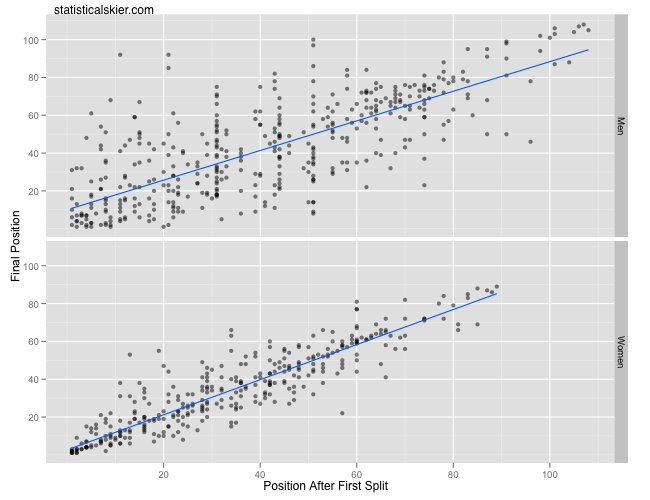Pacing is a frequent topic of conversation in skiing, or really any endurance sport. Typically, the refrain is ‘don’t start to fast‘. In fact, I feel like I hardly ever hear people recommending that one should start a race harder. It must happen occasionally (and I’ll share a story about this later), but I suspect endurance athletes have a general bias towards worrying about going too hard early in a race rather than too easy.
If someone tells me that I shouldn’t start a race ‘too fast’, my first question is ‘Too fast compared to what?’ There are only two things skiers could compare themselves to: (1) the maximum speed that you, personally, could sustain during an entire race, and (2) the speed your competitors are travelling at.
Split times from races give you direct information about (2), which in turn gives us only indirect information about (1). Think for a moment about how runners can learn to tell how fast they’re going based on how they feel. Runners can run on a fixed course (e.g. track, fixed road or trail course) and glance at their watch every lap or every mile and get instant feedback on the connection between how they feel and how fast they’re running. Even with the aid of GPS devices, skiers don’t have a concrete, objective measure of speed to compare themselves to that’s independent of weather, snow conditions, wax, etc. They can’t look at their watch, see that they skied 1km in 2:47 and have that mean something to them. Obviously, skiers do develop a sense for pacing, and probably a pretty good one, too. It’s just harder and they have to do it mostly be feel.
Let’s think carefully about how we’d show with data that someone started ‘too hard’ in an interval start race. The first thing we’d look for is their split times slowing down during the later stages of the race, right? But how do we know for sure that this race tactic would be slower compared to the alternate universe in which the skier started at a slower pace? It’s possible that the time they lost late in the race is balanced out, or even outweighed, by the time they gained early in the race. Ultimately, it’s tough to know for sure without a time machine that let’s us go back and repeat the race using different tactics. Runners (particularly track runners) can experiment with these sorts of tactics with a fairly high level of precision, but skiers have to use whatever innate sense they develop over time.
Obviously, I’m not saying that it’s impossible to tell when you’ve started too hard. I’ve bonked in races myself, you know. My point is that while the extreme cases of poor pacing in either direction are easy to spot, there’s probably a large grey area that’s difficult to navigate with any certainty, at least in skiing.
Let’s get back to the old adage, ‘Don’t start too hard’. My point with this post is that this advice only makes sense compared to yourself (1) not your competitors (2). As I said above, how fast you’re going compared to everyone else is surely correlated with how fast you can go relative to own potential, but if you start too hard in a race against Petter Northug and bonk, it isn’t Northug that caused your body to shut down, it’s your own limitations.
In fact, we can easily flip this around and say that compared to everyone else, you can never start too fast. What do I mean by that? Well, one of the first things that has jumped out at me while digging through the split times from the past WC season is how closely correlated early splits are with final performance, particularly in interval start races:
 These are just the interval start races from last season, so the race distances are 5km, 10km and 15km and the ‘first split’ ranges from 1-2.5km into the race. The women exhibit a stronger correlation, most likely due to the fact that their races are shorter, so there’s less time for things to change after the first split.
These are just the interval start races from last season, so the race distances are 5km, 10km and 15km and the ‘first split’ ranges from 1-2.5km into the race. The women exhibit a stronger correlation, most likely due to the fact that their races are shorter, so there’s less time for things to change after the first split.
Now, there are clearly some extreme cases of poor pacing in this graph. There’s a guy who hit the first split in 11th place and ended up in 92nd (Kein Einaste). And I’m not denying that shifts of 10-20 places, which this graph suggests is commonplace, is of huge practical importance in ski racing. But from a bird’s eye perspective, it’s unlikely that you will finish in the top twenty if you can’t ski one of the twenty fastest times over the first 1-2km. (The inverse is probably not true due to selection bias.)
As an example, only about 1 time in 5 did a skier finish in the top 10 after passing through the first checkpoint outside the top 15.
The story I promised you about being told to start faster is possibly an apocryphal one, since I’ve heard several versions of this tale involving a range of famous skiers. The one I remember hearing first was told to me as follows: Thomas Wassberg, was asked to comment on a 50km performance by a very young Björn Dæhlie in which he skied near the top of the field for much of the race before fading badly towards the end. Specifically, Wassberg was asked whether he thought Dæhlie ought to have skied slower out of the start. He replied, “No, he started at just the right pace. It’s his pace towards the end of the race that he needs to work on.”
[ad#AdSenseBanner]
{ 4 } Comments